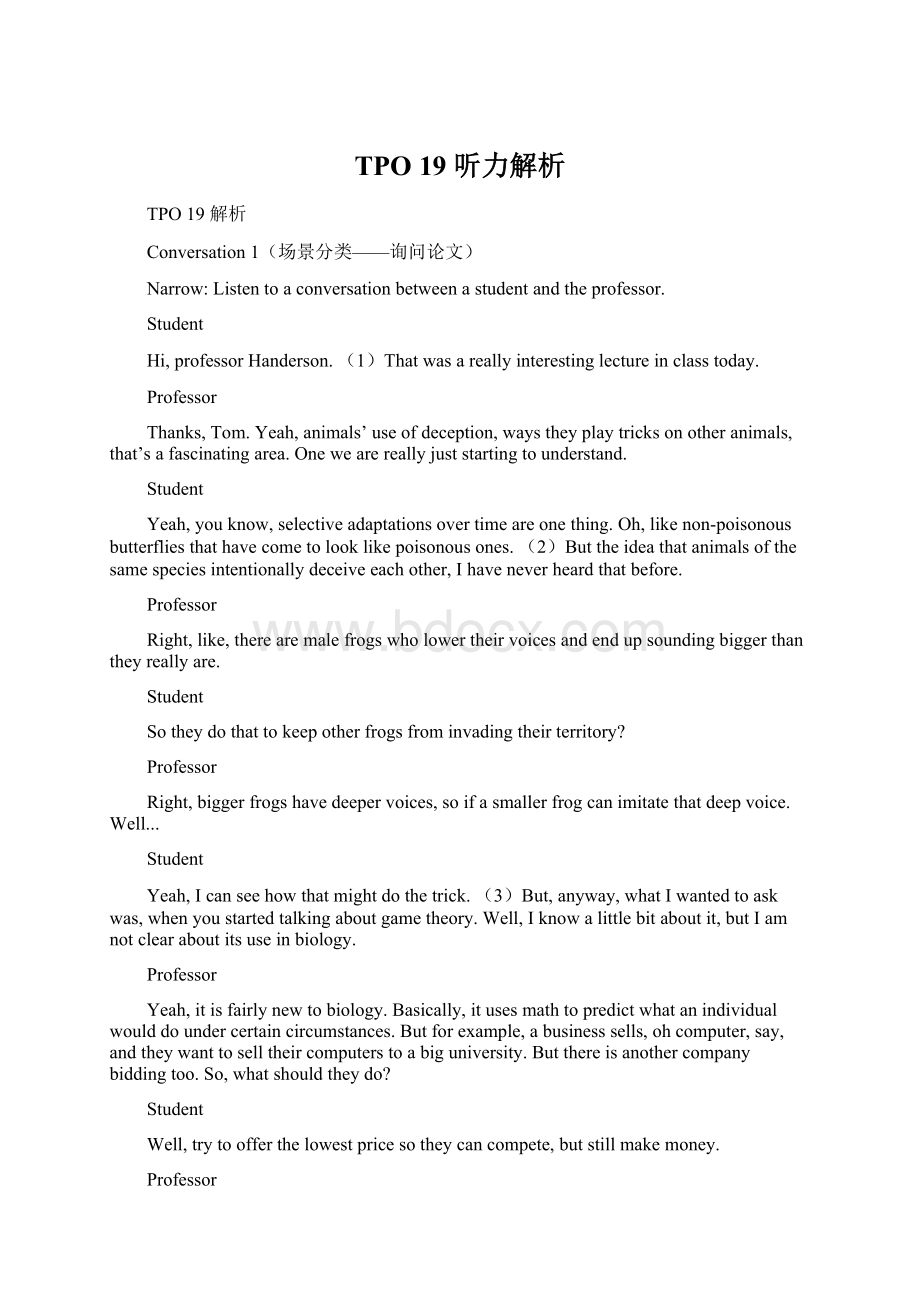TPO 19 听力解析.docx
《TPO 19 听力解析.docx》由会员分享,可在线阅读,更多相关《TPO 19 听力解析.docx(18页珍藏版)》请在冰豆网上搜索。

TPO19听力解析
TPO19解析
Conversation1(场景分类——询问论文)
Narrow:
Listentoaconversationbetweenastudentandtheprofessor.
Student
Hi,professorHanderson.
(1)Thatwasareallyinterestinglectureinclasstoday.
Professor
Thanks,Tom.Yeah,animals’useofdeception,waystheyplaytricksonotheranimals,that’safascinatingarea.Onewearereallyjuststartingtounderstand.
Student
Yeah,youknow,selectiveadaptationsovertimeareonething.Oh,likenon-poisonousbutterfliesthathavecometolooklikepoisonousones.
(2)Buttheideathatanimalsofthesamespeciesintentionallydeceiveeachother,Ihaveneverheardthatbefore.
Professor
Right,like,therearemalefrogswholowertheirvoicesandendupsoundingbiggerthantheyreallyare.
Student
Sotheydothattokeepotherfrogsfrominvadingtheirterritory?
Professor
Right,biggerfrogshavedeepervoices,soifasmallerfrogcanimitatethatdeepvoice.Well...
Student
Yeah,Icanseehowthatmightdothetrick.(3)But,anyway,whatIwantedtoaskwas,whenyoustartedtalkingaboutgametheory.Well,Iknowalittlebitaboutit,butIamnotclearaboutitsuseinbiology.
Professor
Yeah,itisfairlynewtobiology.Basically,itusesmathtopredictwhatanindividualwoulddoundercertaincircumstances.Butforexample,abusinesssells,ohcomputer,say,andtheywanttoselltheircomputerstoabiguniversity.Butthereisanothercompanybiddingtoo.So,whatshouldtheydo?
Student
Well,trytoofferthelowestpricesotheycancompete,butstillmakemoney.
Professor
Right,theyarecompeting,likeagame,likethefrogs.Thereareriskswithpricingtoohigh,thecompanymightgetthesale,thereisalsothenumberandtypeofcomputerstoconsider.Eachcompanyhastofindabalancebetweenthecostandbenefits.Well,gametheorycreatesmathematicalmodelsthatanalyzedifferentconditionslikethistopredictoutcomes.
Student
Ok,Igetthat.Buthowdoesitapplytoanimals?
Professor
(4)Well,youknow,ifyouareinterestedinthistopic,itwouldbeperfectforyourtermpaper.
Student
Theliteraturereview?
Professor
Yeah,findthreejournalarticlesaboutthisoranothertopicthatinterestsyouanddiscussthem.Ifthereisaconflictintheconclusionsorsomething,thatwouldbeimportanttodiscuss.
Student
(5)Well,fromwhatIhavelookedatdealingwithgametheory,Ican’tsayIunderstandmuchofthestatisticsend.
Professor
Well,Icanpointyoutosomethatpresentsfairlybasicstudies,thatdon’tassumemuchbackgroundknowledge.You’lljustneedtoanswerafewspecificquestions:
Whatwastheresearchers’hypothesis?
Whatdidtheywanttofindout?
Andhowdidtheyconducttheirresearch?
Andthentheconclusionstheycameto.Learningtointerpretthesestatisticswillcomelater.
词汇:
deceptionn.欺骗
selectiveadj.选择性的
deceivev.欺骗
invadev.侵略
territoryn.领土
imitatev.模仿
bidv.投标;出价
hypothesisn.假设
题目:
1.Whydoesthemangotoseetheprofessor?
解析:
主旨题,文中学生开头说教授今天课上的演讲很有趣,接着讨论了课上的内容。
答案:
Toaskaboutapointraisedinarecentlecture
2.Whydoestheprofessormentionmalefrogsthatlowertheirvoices?
解析:
细节题,定位malefrogsthatlowertheirvoices.文中学生说从没听过同种生物之间的欺骗,教授紧接着举青蛙的例来说明动物的欺诈行为。
答案:
Togiveanexampleofdeceptivebehaviorinanimals
3.Whydoestheprofessortalkaboutcomputers?
解析:
细节题,定位computers.学生先提出“博弈论(gametheory)”这个概念,说自己不是很了解它在生物学中的作用,教授就给出电脑的例子帮助他了解博弈论。
答案:
Tohelpthemanunderstandgametheory
4.Whatdoesthemanneedtodoforhistermpaper?
解析:
细节题,定位termpaper.教授让学生找3篇相关的文章,如果它们的结论有冲突,就进行讨论,所以学生需要总结一些已出版研究的信息。
答案:
Summarizetheinformationinseveralpublishedstudies
5.Themanexpressesreservationsaboutthesuggestedtopicforhistermpaper.Whatistheprofessor'sattitudetowardtheman'sreservations?
解析:
意图推测题。
学生表示自己可能不能完全理解自己研究的东西,教授说他只需展示一些基础研究,并不需要很多背景知识,所以他的担忧不必要。
答案:
Shethinkstheman'sworriesareunnecessary
Lecture1Linguistics(学科分类——语言学)
Narrator:
Listentopartofalectureinalinguisticsclass.
Professor
Allright,sofarwe’vebeenlookingatsomeofthecoreareasoflinguistics,likesyntax,phonology,semantics,andthesearethingsthatwecanstudybylookingatonelanguageatatime,howsounds,andwords,andsentencesworkinagivenlanguage.Butthebranchofhistoricallinguistics,involvesthecomparisonofseveraldifferentlanguages,orthecomparisonofdifferentstagesofasinglelanguage.Now,ifyouarecomparingdifferentlanguages,andyounoticethattheyhavealotincommon.(7)Maybetheyhavesimilarsoundsandwordsthatcorrespondtooneanotherthathavethesamemeaningandthatsoundsimilar.Let’suseareal-worldexample.Inthe18thcentury,scholarswhohavestudiedtheancientlanguages,Sanskrit,LatinandGreek,noticedthatthesethreelanguageshadmanysimilarities.Andtheremightbeseveralreasonswhylanguagessuchasthesehadsomuchincommon.Maybeithappenedbychance,maybeonelanguagewasheavilyinfluencedbyborrowedwordsfromtheother.Ormaybe,maybethelanguagesdevelopedfromthesamesourcelanguagelongago.Thatis,maybetheyaregeneticallyrelated.ThatwaswhathappenedwithSanskrit,LatinandGreek.Theselanguageshadsomanysimilaritiesthatitwasconcludedthattheymusthaveallcomefromthesamesource.(8)Andtalkaboutimportantdiscoveriesinlinguistics,thiswascertainlyoneofthem.ThescholarsreferredtothatsourcelanguageasProto-Indo-European.
Proto-Indo-Europeanisareconstructedlanguage.Meaning,itiswhatlinguistsconcludedaparentlanguageofSanskrit,LatinandGreekwouldhavetobelike.AndProto-Indo-Europeanbranchedoutintootherlanguages,whichevolvedintoothers.Sointheend,manylanguagesspokenallovertheworldtodaycantracetheirancestrybacktoonelanguage,Proto-Indo-European,whichwasspokenseveralthousandyearsago.(9)Now,onewayofrepresentingtheevolutionoflanguages,showingthewaylanguagesarerelatedtoeachother,iswiththefamilytreemodel.Likeafamilytreethatyoumightusetotracebackthroughgenerationsofancestors,onlyit’sshowingafamilyofgeneticallyrelatedlanguagesinsteadofpeople.Atreemodelforalanguagefamilystartswithonelanguage,whichwecallamotherlanguage.Forexample,Proto-Indo-European.Themotherlanguage,isthelineonthetopofthisdiagram.Overtime,itbranchesoffintonewdaughterlanguages,whichbranchintodaughterlanguagesoftheirown,andlanguagesthathavethesamesource,thesamemother,arecalledsisters.Theysharealotofcharacteristics,andthiswentonuntilwearelookingatabigupsidedowntreelanguageslikethis.Itisincompleteofcourse,justtogiveyouanidea.Sothat’sthefamilytreemodel,basically.
Now,thetreemodelisaconvenientwayofrepresentingthedevelopmentofalanguagefamilyandofshowinghowcloselyrelatedtwoofmorelanguagesare.Butitisobviouslyverysimplified.(10)Havingawholelanguagerepresentedbyjustonebranchonatreedoesn’treallydojusticetoallthevariationswithinthatlanguage.Youknow,SpanishthatspokeninSpainisn’texactlythesameasSpanishthatisspokeninMexico,forexample.(11)Anotherissueisthatlanguagesevolveverygradually,butthetreemodelmakesitlookliketheyevolveovernight,liketherewasadistinctmomentintimewhenamotherlanguageclearlybrokeoffintodaughterlanguages.Butitseemstomeitprobablywasn’tquitelikethat.
词汇:
linguisticsn.语言学
linguistn.语言学家
syntaxn.语法
phonologyn.语音体系;音韵学
semanticsn.语义学
comparisonn.比较;对照
real-worldadj.现实生活的
Sanskritn.梵文
Proto-Indo-Europeann.原始印欧语系
reconstructv.改造;重建
ancestryn.祖先
geneticallyadv.从基因方面
dojusticeto公平对待;适当处理
题目:
6.Whatdoestheprofessormainlydiscuss?
解析:
主旨题,本文是讲一种对有相同语源的不同语言的表述——语言学家称之为Proto-Indo-European.
答案:
Awaytorepresentlanguagesthataregeneticallyrelated.
7.Whatpointdoestheprofessormakewhenshesaysthatsomelanguageshavesimilar-soundingwords?
解析:
细节题,定位havesimilar-soundingwords.文中教授用了一系列假设(maybe)来推测语言有相似之处的原因,说明对此不止一种解释。
答案:
Thereismorethanonepossibleexplanationforsimilaritiesamonglanguages.
8.Whatdoestheprofessorsaywasanimportantdiscoveryinlinguistics?
解析:
细节题,定位importantdiscoveryinlinguistics,注意meaning后面的内容。
文中说语言学家推断Sanskrit,Greek和Latin三种语言有共同的源语。
答案:
Sanskrit,Greek,andLatinhadthesameparentlanguage.
9.Basedonthediscussion,whatinformationcanbeshownonatreemodel?
解析:
推测题,定位treemodel.文中是用家谱与语言树形模型对比,家谱可以供不同后代用来追溯相同的祖先,语言树形模型也有这个功能。
答案:
Thatseverallanguagesshareacommonancestor
10.Whydoestheprofessormentionvariationwithinalanguage?
解析:
意图推测题,定位variationwithinalanguage.文中说语言树形模型并不能反应一种语言所有的变异,像是西班牙语在墨西哥跟西班牙是不同的,所以提到这个是为了指明树形模型不能反应的信息。
答案:
Topointoutinformationthatthetreemodeldoesnotshow.
11.Whatcanbeinferredabouttheprofessorwhenshesaysthis:
解析:
复听意图推测题。
教授用but否定前面一句话的观点,即
答案:
Shedoesnotthinkthatlanguageschangequickly
TPO19Lecture2Astronomy(学科分类——天文学)
Narrator:
Listentopartofalectureinanastronomyclass.
Professor
SohowmanyofyouhaveseentheMilkyWay,theMilkyGalaxyinthesky?
You,youhave?
Student
Yeah,Iwascamping,andtherewasnomoonthatnight,itwassuperdark.
Professor
Anybodyelse?
Nottoomany.(12)Isn’tthatstrangethattheMilkyWayisthegalaxythattheplanetearthisin,andmostofushaveneverseenit?
Now,what’stheproblemhere?
Student
(13)Lightpollution,right?
Fromstreetlightsandstuff.
Professor
Yes,especiallyunshieldedstreetlight,youknow,onesthataren’tpointeddownward.Now,here’sanirony.Thebuildingweareinnow,theastronomybuildingnotfarfromourobservatory,hasunshieldedlights.
Student
Sotheproblemisprettywidespread.
Professor
Itisbasicallybeyon